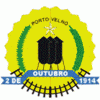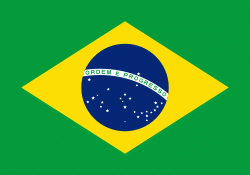Porto Velho (Porto Velho)
 |
The municipality occupies most of the border between Amazonas and Rondônia, and is both the westernmost and northernmost city in the state.
Officially founded on October 2, 1914, Porto Velho was founded by pioneers around 1907, during the construction of the Madeira-Mamoré railroad. After the railroad was completed, the local population was about one thousand inhabitants; its buildings were chiefly the railway's installations and the wooden houses of the Caribbean (mainly Barbadian) workers - hence the name of the town's largest district by then, "Bajan Hill" or "Barbados Town", nowadays called the "Alto do Bode".
During the first sixty years, the city's development was directly connected to the railway's activities. The town prospered during the rubber boom, but then when low-cost Malaysian rubber made rubber from the Amazon uncompetitive, the region's economy ground to a halt. Cities like Santo Antônio do Madeira, which had a tram line and a weekly newspaper by the time of Porto Velho's foundation, are nothing but ruins nowadays.
Porto Velho's survival is associated with the better conditions of the area where it was built, its easy access by the river and its harbor: these were all considerations in the choice of Porto Velho as the capital of the newly formed Federal Territory of Guaporé, in 1943. Only with the beginning of World War II was there another cycle of progress in the region. When the Allied forces lost control over the Malaysian rubber, Amazon's was needed due to the war effort. This produced what is known in Brazil as the "second rubber boom". But when the war ended, the region's economy once again came to a halt.
Porto Velho's modern history begins with the discovery of cassiterite around the city, and of gold on the Madeira River, at the end of the 1950s. In addition, the government's decision to allow large cattle farms in the territory began a trend of migration into the city. Almost one million people moved to Rondônia, and Porto Velho's population increased to three hundred thousand. This intense migration caused much trouble for the city. Among many other problems, the suburban boroughs, for example, are nothing but shanty towns.
Its Catedral Metropolitana Sagrado Coração de Jesus, is the cathedral archiepiscopal see of a Latin Catholic jurisdiction that started on May 1, 1925 as the vast Amazonian Territorial Prelature of Porto Velho on territories split off from the then Diocese of Amazonas and Diocese of São Luíz de Cáceres and lost parts of it to three new Territorial prelatures before being promoted first bishopric (Diocese of Porto Velho) and on October 4, 1982 promoted as Metropolitan Archdiocese of Porto Velho.
Map - Porto Velho (Porto Velho)
Map
Country - Brazil
Currency / Language
| ISO | Currency | Symbol | Significant figures |
|---|---|---|---|
| BRL | Brazilian real | R$ | 2 |
| ISO | Language |
|---|---|
| EN | English language |
| FR | French language |
| PT | Portuguese language |
| ES | Spanish language |


















